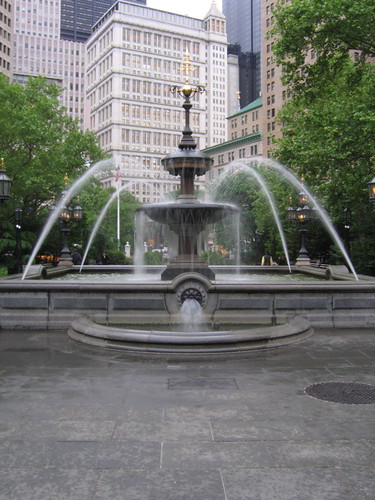
Quantum physicists are either aghast or agog nowadays about the possibility of a T.O.E., a "Theory of Everything." Essentially, the argument runs that singularity is virtually impossible, that all things connect to all other things and one needs, to paraphrase E.M. Forster, "only [to] connect." The disclaimer that must, therefore, precede the body of this essay is that its writer likes the connection idea. One can easily make the argument that synthesis represents the most genuine form of learning. Juxtapose items one and two and discover a third that is neither.
With this in mind, let us think about the City Hall Park fountain. It is less familiarly known as the Mould Fountain after the architect who collaborated in the design of Central Park with Frederick Olmsted and Calvert Vaux. Mould's fountain stood where it presently does, in lower City Hall Park, from 1871 to 1920 astride the Mullett Post Office. In 1920, it was carted up to Crotona Park in the Bronx until Mayor Guliani returned it to where it had started its life. The Mould Fountain has thus traced a neat little gyre that frames its life.
Find the greensward at the southern entrance to the park and there is the Mould Fountain. If one were to have looked there two hundred years ago, there would have been a public "hydrant," the first tap of the new water supply generated by the Croton aqueduct system. Look there today and one finds the fountain, back since the Guiliani years, but surrounded by 1990s gaslights and benches, greenery, but no post office.
The Croton system solved the cholera problem invariably created by Collect Pond. The Croton system allows New York City to justly claim that it has one of the purest water supplies of any municipality in the United States. Water became a starting point for the "conspiracy" discussed in the preceding post, and the problem of low water pressure increased the danger of devastating fires such as those of 1741, 1776, and 1835. Water, "tea-water," fires, conspiracies, a post office in the Second Empire style, and a first public tap. All these things merge in today's lower City Hall Park and its cooling fountain with pathway marking, almost invisibly, what once was known as "Mail Street."

No comments:
Post a Comment